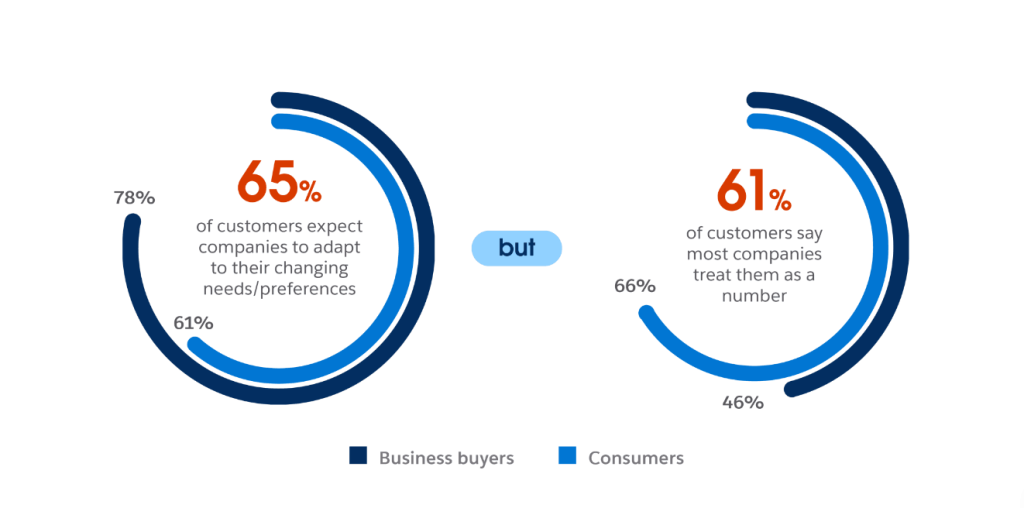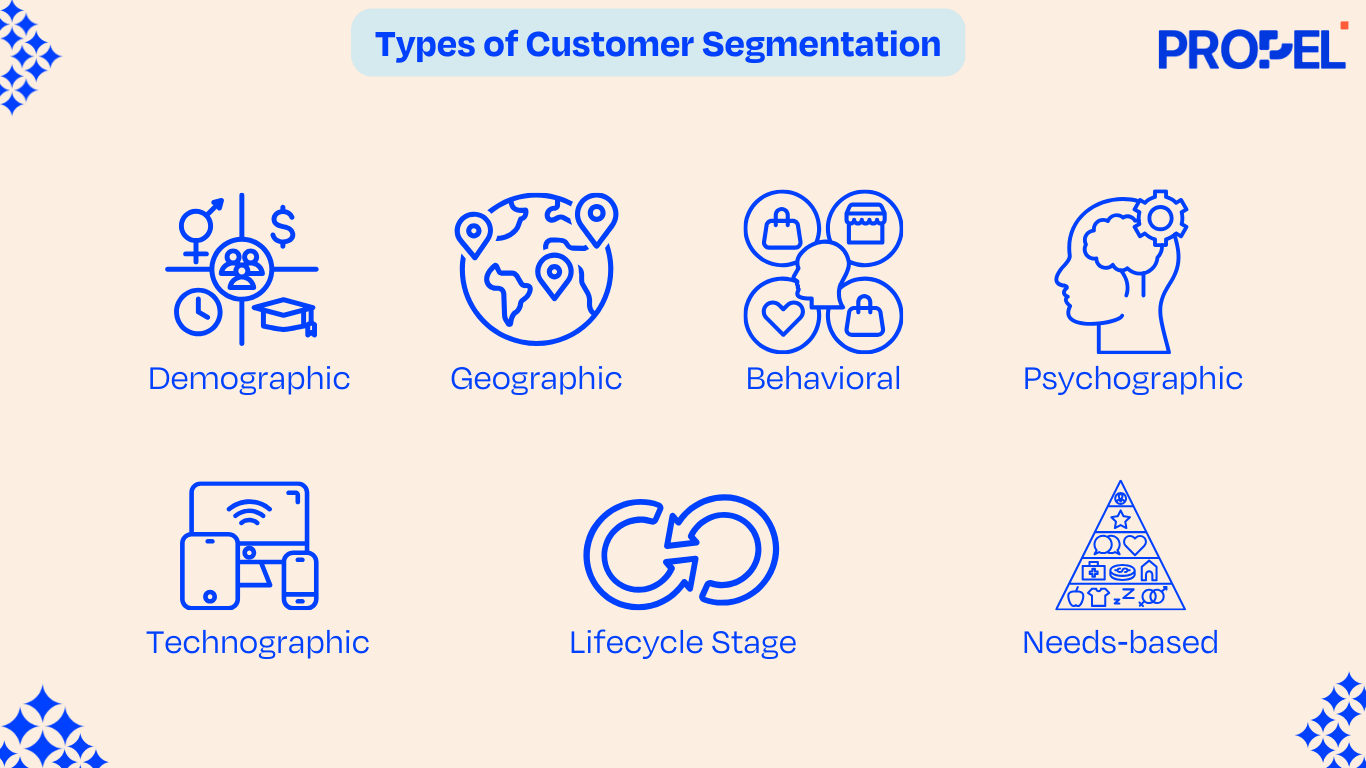In today’s dynamic business landscape, personalization has become a necessity. A one-size-fits-all approach no longer meets the diverse preferences, needs, and behaviors of modern consumers. In fact, nearly 80% of consumers prefer personalization that caters to their experiences, making segmentation essential for effective communication. This shift has made customer segmentation a vital strategy in marketing.
Customer segmentation is the process of dividing a company’s customer base into distinct groups based on common characteristics. These characteristics could be demographic (age, income), geographic (location), psychographic (values, lifestyle), or behavioral (purchase patterns). By identifying these groups, companies can tailor their marketing and sales strategies to better address the needs of each segment.
Why is this important? Marketing to a broad, undefined audience is inefficient and can lead to wasted resources. Segmentation allows businesses to target the right message to the right customer, which not only increases engagement but also drives sales and customer loyalty. It is also observed that companies that prioritize segmentation see greater customer retention and improved overall brand experience.
Let’s explore three key benefits of how one of the cornerstones of Lifecycle Management which is segmentation can help aid the Customer Journey:
1. Enhanced Customer Relationship and Brand Loyalty
Today’s consumers crave personalized marketing. Nearly two-thirds expect brands to tailor messages to their individual needs. And personalization is encouraged when a company understands customer behavior, because then it can craft marketing campaigns that resonate personally. By delivering personalized content and offers based on specific preferences or behaviors, businesses foster stronger connections with their customers. This personalized approach encourages repeat purchases, leading to brand loyalty. For example, a clothing retailer might offer specific product recommendations based on a customer’s previous purchases, thus creating a more relevant shopping experience. This allows for a more nuanced relationship with customers increasing customer satisfaction and ultimately driving repeat purchases.
2. Improved Customer Experience and Sales
Segmentation also allows businesses to align their marketing strategies with customer needs. By tracking customers’ behavior or purchase history, companies can predict when a customer might be ready for a new product or service. This ensures that customers receive timely promotions and relevant offers, enhancing their overall experience. The result? A more satisfied customer base and a stronger likelihood of repeat sales.
3. Time and Resource Efficiency
Efficient resource allocation is another significant advantage of customer segmentation. By identifying the most profitable customer segments, businesses can allocate their marketing budget and sales efforts where they’ll have the most impact. This reduces the waste of time and resources on less valuable segments, ultimately improving the company’s profitability.

Description: The sheer demand of personalization in marketing (Source: Salesforce)
There are various ways to segment a customer base, depending on the industry and business goals. Below are the most common types:
1. Demographic Segmentation
Demographic segmentation groups customers based on shared characteristics such as age, gender, income, occupation, education level, or family status. This is one of the simplest and most commonly used segmentation methods because demographic data is often readily available and easy to collect.
2. Geographic Segmentation
Geographic segmentation divides customers based on their location, including country, city, neighborhood, or even climate. It’s especially important for companies with a diverse geographic customer base, as people in different areas often have different needs and purchasing habits.
3. Psychographic Segmentation
Psychographic segmentation focuses on customers’ lifestyles, interests, values, and personality traits. This type of segmentation dives deeper than demographic or geographic data, offering insights into what motivates customers.
4. Behavioral Segmentation
This approach segments customers based on their behavior with the product or service. Behavioral segmentation often takes into account purchase history, brand loyalty, frequency of purchases, and engagement with marketing campaigns.
5. Needs-Based Segmentation
This method groups customers based on their specific needs or the solutions they’re looking for. It’s particularly useful in industries where product features or services are tailored to meet varying demands.
6. Technographic Segmentation
Technographic segmentation categorizes customers based on the technology they use, including devices, software, and applications. For businesses in the tech industry or any industry that involves digital interaction, this is a critical way to optimize customer engagement strategies.

Major types of Customer Segmentation
Effective segmentation requires the right data, and that’s where Customer Data Management (CDM) comes into play. CDM is a system that collects, organizes, and analyzes customer data across multiple channels, ensuring businesses have accurate and comprehensive information to work with.
A robust CDM platform allows businesses to segment their customer base more efficiently by automatically categorizing customers based on pre-determined criteria. By integrating CDM with segmentation strategies, companies can:
Customer segmentation is particularly effective when used in Lifecycle Marketing, which tailors marketing efforts to where a customer is in their buying journey. Here’s how it works:
1. Awareness Stage: For customers in the early stages of their journey, businesses can segment based on demographics and interests to build awareness. A brand might target young professionals with ads highlighting the sleek, modern features of a new tech gadget.
2. Consideration Stage: As customers move toward consideration, companies can use behavioral segmentation to re-target those who have engaged with previous content. A brand may send personalized emails with product comparisons to users who visited a specific product page.
3. Decision Stage: At this stage, behavioral segmentation can again be valuable. Businesses can segment customers who are close to making a purchase and offer them a special discount or promotion to seal the deal.
4. Retention Stage: Segmentation doesn’t stop once a customer has made a purchase. Needs-based or behavioral segmentation allows businesses to nurture relationships with post-purchase engagement, encouraging repeat sales or subscriptions.
Let’s take a look at a couple of examples of companies that have leveraged segmentation to drive success:
1. Dunkin Donuts: Dunkin’ Donuts integrated data collected from their mobile app engagement strategy, which ultimately paved the path to a successful segmentation exercise, to send customized offers and product recommendations to customers of each segment. Analyzing the data collected also allowed them to optimize store locations and curating the menu for these stores as per the preferences of customers.
2. Coca-Cola: Coca-Cola tailors its product offerings based on geographic and cultural segmentation. In Asian markets, the company promotes teas and juices, while in Western markets, soft drinks are more prevalent. This region-specific approach has helped Coca-Cola maintain its global presence.
3. Amazon: Amazon excels at using demographic, behavioral, and psychographic segmentation to create personalized shopping experiences. From product recommendations based on past purchases to targeted ads, Amazon’s segmentation strategy significantly enhances customer satisfaction.
Customer segmentation is more than a marketing strategy; it’s a tool that empowers businesses to understand their audience on a deeper level. Besides segmentation has helped businesses increase conversion by 50% and reduce costs by 30% for the marketing team. By dividing customers into specific, actionable segments, companies can tailor their marketing efforts, improve customer satisfaction, and drive long-term retention.
In an increasingly competitive marketplace, the businesses that can deliver personalized experiences will be the ones that thrive. Whether you’re targeting based on demographics, behavior, or psychographics, segmentation enables you to connect with your customers in a meaningful way—ultimately boosting your business growth.

Jaskaran Lamba is the co-founder of Propel, a MarTech consultancy committed to advancing marketing operations and retention strategies. A certified marketing automation specialist with a background in management consulting, Jaskaran has extensive experience advising clients globally on engagement, growth, and retention. He combines his strategic expertise, honed at IIT Madras, with a passion for business growth and customer success.
Got Questions? We Have Answers!
Segmentation delivers personalized experiences, enhancing engagement at each lifecycle stage.
It enables efficient, targeted marketing that boosts customer loyalty and retention.
By tailoring outreach, segmentation attracts high-fit customers, improving conversion rates.
It helps predict needs, allowing timely, relevant offers that drive purchases.
Data management refines segmentation accuracy, ensuring relevant, real-time customer insights.

Propel specializes in customer lifecycle marketing, helping consumer brands boost retention & reduce churn with tailored strategies and our AI-augmented platform, AURA.
Book a call with our experts and get started today!